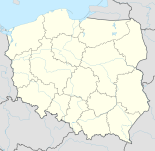Wyssoka
| Wyssoka Wysoka |
||
|---|---|---|

|
|
|
| Basic data | ||
| State : | Poland | |
| Voivodeship : | Opole | |
| Powiat : | Strzelce Opolskie | |
| Gmina : | Leschnitz | |
| Geographic location : | 50 ° 28 ′ N , 18 ° 10 ′ E | |
| Residents : | 400 | |
| Postal code : | 47-150 | |
| Telephone code : | (+48) 77 | |
| License plate : | EAST | |
| Economy and Transport | ||
| Street : | A4 | |
| Next international airport : | Katowice | |
Wyssoka ( Polish Wysoka ; German 1933-45 Hohenkirch ) is a village in the bilingual Polish municipality of Leschnitz (Leśnica) in the Powiat Strzelecki of the Opole Voivodeship .
geography
Wyssoka is located around 25 kilometers southeast of Opole and 5 kilometers north of Leschnitz in historic Upper Silesia . The street village Wyssoka connects directly to the north to the village Sankt Annaberg , whereby the places were cut up by the construction of the A4 motorway .
history
The area of Wyssoka was already settled in the Middle Ages, which is confirmed by the remains of a castle from the 13th century discovered here, as well as vessels from this period. Wyssoka was first mentioned as Visoka in a document by Henry the Bearded in 1234 . At that time it belonged to the monastery in Czarnowanz . Wyssoka Church was first mentioned in 1371. A Sbrosco de Wysoka was mentioned in documents from 1342 and 1353 . In contrast, a Teodor de Wissoka appears in the prince's letter to the monks from Himmelwitz dated April 17, 1361. In 1421 this village belonged to the property of a Petrasz Stral.
In 1474, the then village owners were hanged in the forest near Wyssoka. Your castle was destroyed. This was done as a punishment for robberies that they carried out on the roads there and the victims of which were mostly merchants.
In 1563 Joachim v. Buchta Wyssoka to Martin Dzierzanowsky. In 1630 the village came through a marriage to Count Johann Georg von Gaschin , who had a castle built there during the Thirty Years' War . It was not until 1733 that ownership passed to the Schimonsky family, in 1782 to von Welczek, von Sack, again to Count Gashin and finally in 1799 to Balthasar von Thun. The last owner was Herta Freifrau von Zedlitz-Neukirch, née von Thun, who sold the castle and property to the province of Upper Silesia in 1927.
According to information from 1817, there were 27 farmers and 9 homeworkers at the time. The whole village had 244 inhabitants. During this time, the Wyssoka colony, founded in 1773, was inhabited by 71 people. In 1843 u. a. mentioned: Castle, Vorwerk , alcohol distillery, brewery, lime kiln and four guest houses. There were also 13 craftsmen and one merchant working in the village. In 1910 Wyssoka had 589 inhabitants and in 1996 417.
In the referendum in Upper Silesia on March 20, 1921, which was accompanied by conditions similar to civil war in the area , 288 people in Wyssoka voted to stay with Germany and 108 for Poland. Wyssoka remained with the German Empire like the entire district of Groß Strehlitz.
In 1933 Wyssoka was renamed Hohenkirch .
In 1945 the place fell to Poland as Wysoka .
In 2006, Gmina Leschnitz , to which Wyssoka belongs as a district, introduced German as an auxiliary language and in 2008 bilingual place names.
Population development
The population of Wyssoka:
|
Footnotes
- ↑ See results of the referendum ( Memento of March 4, 2016 in the Internet Archive ); down. on October 17, 2009
- ↑ Sources of population figures :


